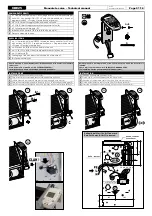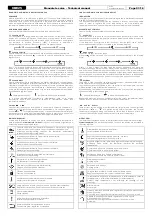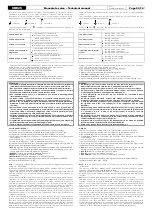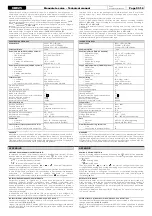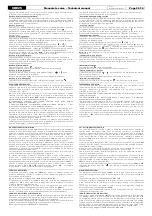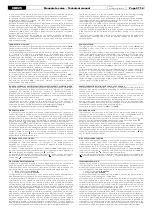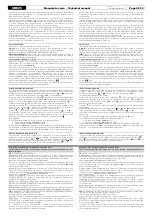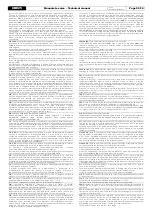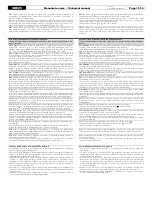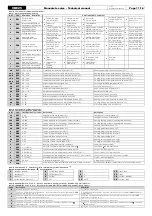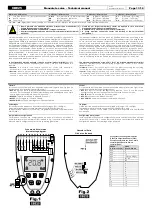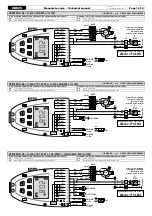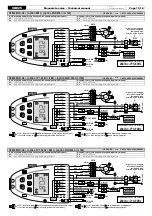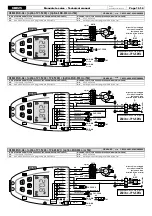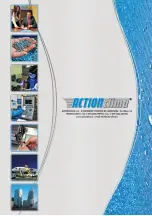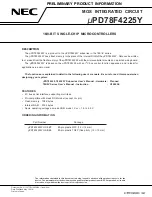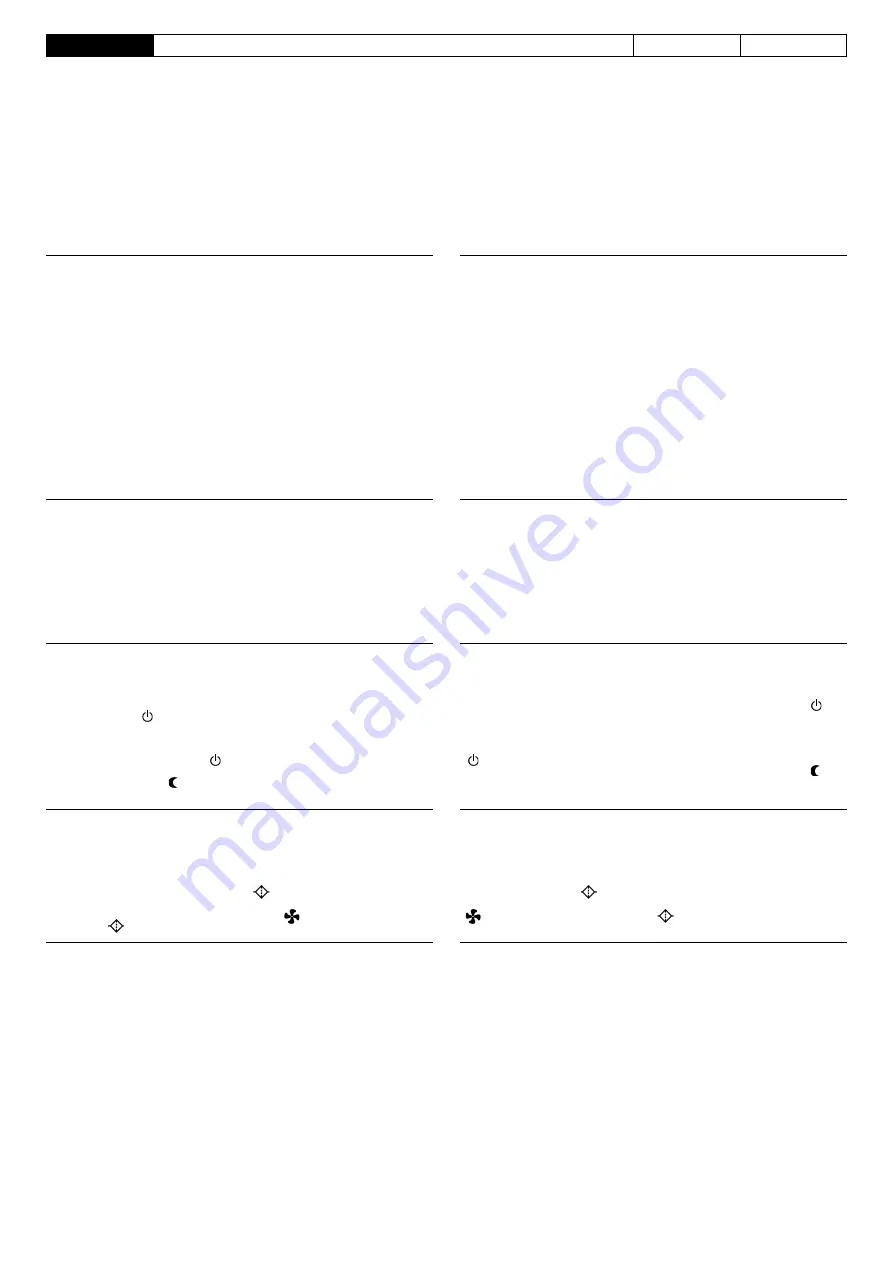
CBE25
Manuale tecnico – Technical manual
Code
MT-CBE25-02021080-R00
Page 07/16
La valvola viene pilotata come in un sistema a due tubi: a seconda se il termostato è impostato
in riscaldamento o in raffrescamento viene gestito il flusso di acqua calda o fredda.
La resistenza invece viene attivata per integrazione quando in riscaldamento la
temperatura ambiente è inferiore alla temperatura di setpoint di ∆ setpoint
configurabile nel parametro
C18
.
Nel modo raffrescamento si può avere una regolazione con zona neutra impostando
l’ampiezza della zona neutra su
P19
maggiore di zero, il questo caso il raffrescamento
si ottiene attivando la valvola mentre il riscaldamento attivando la resistenza.
In questo tipo di impianto è consigliabile impostare un ritardo allo spegnimento del
ventilatore su
P21
in modo tale che allo spegnimento della resistenza il ventilatore
continui a girare per smaltirne il calore.
Nel caso in cui, in questo tipo di impianto si usi anche la funzione “termostato di
minima” in riscaldamento, il ventilatore non sarà mai interdetto qualora l’acqua di
mandata non sia sufficientemente calda in quanto verrà anticipata l’accensione
della resistenza elettrica.
The valve is driven as in a two pipes system: according to the heating or cooling
setting of the controller the relevant flow of hot or cool water is managed.
The electric heater is turned on as an additional (integrating) heat source whenever,
in heating mode, the room temperature falls below the set point temperature by a ∆
setpoint that can be configured in parameter
C18
.
In cooling mode it is possible to have a neutral zone regulation by setting a neutral
zone width greater than zero on
P19
. In this case cooling is achieved by activating the
valve, while heating by activating the electric heater.
In this type of system it is suggested to set a delay on the fan switch-off on
P21
, so that
when the electric heater is switched off, the fan keeps running to cool the heater
down.
In case the cut-off temperature function is used in this system, the fan will never be
inhibited while in heating mode, since the electrical heater will be turned on in
advance instead.
SISTEMA POMPA DI CALORE
Il termostato può essere configurato per gestire un impianto pompa di calore (
P01=4
)
e quindi pilotare la valvola di inversione sull’uscita della valvola caldo e il compressore
sull’uscita della valvola freddo.
L’uscita della valvola di inversione sarà sempre accesa o sempre spenta a seconda
se il temostato è impostato in riscaldamento o in raffrescamento. Nel modo
riscaldamento la valvola di inversione viene alimentata mentre rimane spenta in
raffrescamento (tipo EUROPA). In alternativa se si collega la valvola sull’uscita al
morsetto 8, la logica di pilotaggio è invertita: in raffrescamento viene alimentata
mentre rimane spenta in riscaldamento (tipo USA).
L’uscita del compressore sarà attivata quando è necessario spostare calore, cioè
quando l’ambiente ha bisogno di essere riscaldato o raffreddato. E’ consigliabile
impostare una temporizzazione dell’uscita compressore sul parametro
C09
per
impedire spegnimenti e riaccensioni repentine.
Nella modalità pompa di calore la sonda di mandata può essere collegata e la sua
funzione diventa di antighiacciamento e/o antisurriscaldamento della batteria.
Se in raffrescamento la sonda rileva una temperatura minore o uguale a
C02
, il
termostato interdice il compressore: funzione antighiacciamento della batteria.
Se in riscaldamento la sonda rileva una temperatura superiore o uguale alla soglia
impostata nel parametro
P22
, il termostato interdice il compressore: funzione
antisurriscaldamento della batteria.
HEAT PUMP SYSTEM
The regulator can be configured to manage a heat pump system (
P01=4
) thus
controlling a 4-way valve wired at the heating output and a compressor at the
cooling output.
The 4-way valve output is always turned on or off according to the heating or cooling
setting of the regulator. In case the “EUROPEAN“ type of driving is chosen, the 4-way
valve is powered in heating mode and left unpowered in cooling. Alternatively, with
the valve wired at terminal 8, the driving logic is reversed: the valve is powered in
cooling and left unpowered in heating (“USA“ type).
The compressor output is active whenever it is necessary to “pump“ the heat, that is
when the room needs to be cooled down or heated up. It is advisable to set a delay
on the compressor output (parameter
C09
) in order to avoid too frequent turn-off and
turn-on.
In the heat pump mode the supply water temperature sensor can still be wired and its
purpose is for protection against freezing or overheating of the heat exchanger.
Should the supply sensor, when in cooling mode, detect a temperature lower than
C02
, the regulator stops the compressor (anti-freeze protection).
On the other hand, should the supply sensor, when in heating mode, detect a
temperature higher than the value stored in parameter
P22
, the regulator stops again
the compressor (over-heat protection).
IMPIANTI A PAVIMENTO CON VENTILCONVETTORE PER RISCALDAMENTO E RAFFRESCAMENTO
Il termostato può essere configurato per gestire un impianto speciale che utilizza mezzi
diversi di climatizzazione a seconda che la necessità sia di riscaldare o di raffreddare
l’ambiente. Per esempio in estate può pilotare un ventilconvettore per il
raffrescamento dell’ambiente pilotando ventilatore e valvola freddo, mentre in
inverno può pilotare la sola valvola caldo dell’impianto a pavimento tenendo sempre
spento il ventilatore del ventilconvettore.
Il termostato può ricevere su un ingresso (piazzole M13/EI o M14/RDC-ECO)
l’informazione dello stato estate/inverno direttamente dalla centrale termica, in
questo modo si avrà una gestione automatica del cambio stagione, con richiamo
automatico del modo di climatizzazione e setpoint della rispettiva stagione.
Per configurare questo tipo di impianto impostare
P01=1
e
P03=4
.
UNDERFLOOR HEATING SYSTEMS WITH FAN COIL FOR COOLING
The thermostat can be configured to manage a special system which uses different
means of temperature conditioning depending on whether heating or cooling is
needed in the room.
For example, in summer season a fan coil can be driven for room cooling by
controlling the fan and the cold valve, while in winter season it could only drive the
hot valve of the underfloor system, always keeping the fan coil fan off.
The thermostat can receive information on the summer/winter status directly from the
heating system on an input (pitches M13/EI or M14/RDC-ECO), in this way there will be
an automatic management of the seasonal changeover, with an automatic recall of
the climate mode and setpoint of the respective season.
To configure this type of system, set
P01=1
and
P03=4
.
FUNZIONE ECONOMY
La funzione Economy permette di impostare temporaneamente una riduzione dei
consumi riducendo la temperatura di setpoint impostata di uno step configurabile
quando in riscaldamento, o aumentando il setpoint dello step configurabile quando
in raffrescamento. Lo step di riduzione si imposta con il parametro
P17
: se questo viene
impostato a 0.0 la funzione Economy è disabilitata. La modalità di risparmio Economy
si attiva da pulsante come spiegato nel paragrafo “Descrizione dei comandi”.
La funzione Economy può essere attivata da remoto in modo centralizzato anche su
più termostati utilizzando gli ingressi alle piazzole M13 o M14 (vedere parametri
C14
e
C15
).
Il termostato è sensibile al cambiamento di stato del segnale e non al livello e quindi è
sempre possibile, tramite il pulsante , cambiare lo stato di attivazione della funzione
Economy anche se è stato forzato dal segnale centralizzato. Quando la funzione
Economy è attiva, icona accesa, essendo una modalità di risparmio, la velocità
del ventilatore sarà limitata alla prima.
ECONOMY FUNCTION
The “Economy“ function allows to temporary set an energy saving mode through a
reduction of the actual setpoint temperature by a step (configurable) when in
heating mode, or increasing it by the same step when in cooling mode.
The value for this reduction step is set with parameter
P17
: when this is set to 0.0 the
Economy function is actually disabled. The Economy mode is activated by the
button, as described in the “Description of controls” section.
The Economy mode can be remotely activated in centralised mode, even for multiple
thermostats, using the inputs to pitches M13 or M14 (see parameters
C14
and
C15
).
Since the thermostat is sensitive to signal status changes and not to the level, use the
button to change the activation status of the Economy function, even when it is
forced by the centralised signal. When the Economy function is activated ( icon
on), fan speed is limited to the first.
FUNZIONE AVVISO FILTRO SPORCO
I ventilconvettori e altri dispositivi funzionanti con un ventilatore sono spesso
equipaggiati di filtro sull’aspirazione, che necessita di una pulizia periodica. Il
dispositivo può avvisare quando è il momento di eseguire la pulizia attivando la
funzione di “avviso filtro sporco”.
La funzione si attiva impostando un tempo sul parametro
P24
, il termostato conta il
tempo di funzionamento del ventilatore e quando raggiunge la soglia impostata in
P24
avvisa facendo lampeggiare l’icona filtro sul display.
Per resettare la segnalazione e azzerare il contatore del tempo, quando si è eseguita
la pulizia, sarà necessario tenere premuto il pulsante per 10 secondi fino a che
l’icona filtro scompare dal display.
DIRTY FILTER WARNING FUNCTION
Fan-coils and other devices including a fan are often equipped with a filter for the air
in the suction path, which needs a periodical maintenance and cleaning or
replacement. This regulator can warn the user when the maintenance has to be
made, provided the “Dirty filter warning“ function has been enabled.
The function is activated by setting the time-to-maintenance on parameter
P24
. The
thermostat will count the fan operation time and when the threshold set in
P24
(per
100 hours) is reached, the filter icon blinks on the display.
Once the filter has been cleaned, to reset the warning and the time counter keep the
button pressed for 10 seconds, until the filter icon disappears from the display.
REGOLAZIONE DELLA TEMPERATURA
Il termostato è in grado di pilotare in maniera proporzionale valvole e ventilatore in
modo da regolare la temperatura ambiente con il massimo comfort e risparmio.
Tuttavia ambienti diversi necessitano di impostazioni diverse al fine di ottenere una
regolazione precisa. I parametri responsabili della qualità della regolazione sono:
Banda proporzionale
C05 e C06
Tempo di integrazione
C07 e C08
Per ognuna delle due impostazioni ci sono due parametri perché è possibile dare
impostazioni diverse a seconda se si è in riscaldamento o raffrescamento.
La banda proporzionale, espressa in °C, è quella differenza tra setpoint e temperatura
ambiente che fa sì che il regolatore apra tutta la valvola. Tanto più stretta è la banda
proporzionale tanto più è reattivo il sistema al variare della temperatura ambiente.
Un’impostazione della banda proporzionale troppo stretta può generare oscillazioni
della temperatura ambiente o instabilità del sistema. Un’impostazione troppo larga
può portare a non raggiungere nell’ambiente la temperatura impostata sul setpoint.
Quando il tempo di integrazione è impostato a zero non si ha nessuna azione
integrativa, e la regolazione è di tipo
P
(Proporzionale). Impostando un tempo di
integrazione diverso da zero la regolazione sarà di tipo
P+I
(Proporz Integrale).
Tanto più piccolo è il tempo integrale tanto più grande è l’azione integrale, viceversa
un tempo integrale lungo genera un’azione integrale blanda. Un’azione integrale
blanda o assente può far sì che non si riesca a raggiungere nell’ambiente la
temperatura impostata sul setpoint. Un’azione integrale troppo forte può generare
delle oscillazioni della temperatura ambiente. E’ necessario ritoccare questi parametri
a seconda dell’ambiente in cui si opera al fine di ottenere la migliore regolazione.
TEMPERATURE REGULATION
This device can drive in a proportional way both valves and fan in order to control
room temperature with the highest comfort and energy saving. Nonetheless each
different environment needs a different set for some parameters in order to get an
accurate regulation. Parameters responsible for the regulation accuracy are:
Proportional band:
C05 and C06
Integral time:
C07 and C08
For each of the settings two parameters are available, because the user is allowed to
set different values for heating and cooling mode.
Proportional band, measured in °C, is intended as the difference between setpoint
and room temperature which is needed to fully open the regulating valve. The
narrower the proportional band, the fastest is the regulator to counteract temperature
variations in the room. Yet a too “narrow“ value for this parameter can result in room
temperature oscillations or system instability. A too “wide“ value could result in the
impossibility to reach the setpoint temperature in the room.
When the integral time is set to zero, no integral action is made and therefore the
regulation is purely proportional (
P
type). When an integral time different from zero is
set the resulting regulation is made of a Proportional plus an Integral action (
P+I
type).
The smaller the integral time, the greater the influence of the integral action and vice-
versa: with a greater integral time the resulting integral action is softer. A too soft or
null integral action could result in the impossibility to reach the setpoint temperature,
meanwhile a too strong integral action could possibly generate oscillations in the
room temperature. It is necessary to adjust these parameters according to the actual
environment in which the regulator is installed to get the best regulation accuracy.
Summary of Contents for CBE25
Page 18: ......


